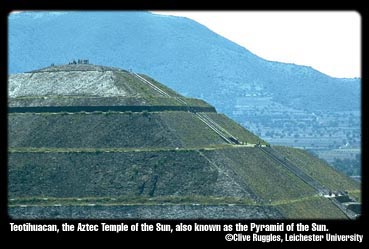|
|
|
In the modern world, many of us spend most
of our time in human-made environments and we tend to take many of the wonders
of the natural world for granted. We don't think about it every day, but
the sun provides us with light, warmth, and energy for plants to grow. Ancient
cultures who were more closely in tune with nature recognized that the sun
was crucial to life on earth. It is not surprising that the sun figures
in myths and legends from almost every corner of the globe.
In this section, we will examine the importance
of the sun and sunspots in ancient cultures, the advent of the telescope,
and how you can (with ordinary binoculars or a telescope) safely view the
sun.
|

The Sun and Sunspots in Ancient Cultures
The ancient Greeks believed that
the sun was the chariot of the god Helios, driven across the heavens by
four horses. For the ancient peoples of Peru, the Inca and the Maya, the
sun was a god, and they carefully observed and recorded the changing arc
that the sun inscribed in the sky throughout the year, forming detailed
calendars. According to
archeoastronomer
and
stellar physicist David Dearborn, there is reason to believe that some Meso-American
cultures recognized sunspots. And although there is no clear evidence that
the Inca or the Maya noticed sunspots, the Aztec myth of creation involves
a sun god with a pock-marked face, which strongly suggests that they had
seen dark blemishes on the sun.
|
|
According to Dearborn, it is not surprising
that most ancient cultures revered the sun as a god. "The sun is a
very powerful force that affects us here on earth. It gives us warmth and
light, and it has the power to grow the plants that humans use as crops.
In the Andes after the Europeans first arrived, the Jesuit priests reported
back to Europe, saying that people here believed the sun had the power to
grow crops. Well, the sun DOES have the power to grow crops, plain and simple."
The Andean peoples were not alone in their attention to the sun; in almost
every early culture around the world, people revered some form of sun god.
|
|
Dearborn continues, "In early stages
of development, humanity looked around itself, and wanted to understand
the sun, because if they could understand things, they might avoid some
problems, such as planting their crops at the wrong time." But, as
Dearborn explains, "their explanations in early days was usually not
that the sun was just a phenomenon. Instead, they tried to understand the
sun, and really all of nature, in a human context. They assigned the sun
the
anthropomorphic
features
of a god, not necessarily completely human, but a very powerful being, who
should be paid attention to, and propitiated with offerings, so that it
would continue to give people the heat and warmth and grow the crops."
|

|
Dave Dearborn discusses the importance of the sun
in ancient cultures.
|

|
|


